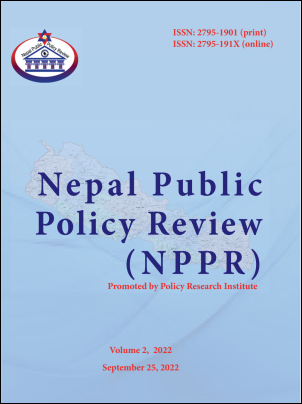A Review of Policies and Institutions for Landslide Risk Management in Nepal
Keywords:
Landslide, Disaster Risk Management, Standard Operating Procedure, Contingency PlansAbstract
Nepal has been experiencing different kinds of natural hazards in recent decades due to its unique topographic and climatic diversities. Earthquakes, landslides, floods, lightning, fire, cold and heat wave are major hazards. Among them, the landslide is one of the major natural hazards, and the occurrence of landslides is due to active tectonics and the Asian monsoon. The Spatio-temporal distribution of landslides in Nepal suggests that fatal landslides had an average of 113 death per year from 1971-2021. Moreover, Sindhupalchowk, Gorkha and Syangja had the highest number of fatal landslides. A proper landslide risk management policy should be implemented to reduce lives and properties. Landslide risk reduction is always challenging because it needs strong political determination, appropriate plans and policies, and good governance. This study reviewed the government's different plans, policies, acts and available literature to understand the status of landslide risk management in Nepal. Key informant interviews were conducted among stakeholders to understand how landslide risks are managed. The Disaster Risk Reduction and Management Act (DRRM), 2017, has considered the evidence-based decision-making processes instrumental in the paradigm shift from response-centric to anticipative and prevention-based approaches. Similarly, the Local Government Operation Act, 2017 has authorised and mandated the local government to undertake various functions for Disaster Risk Reduction. It is found that most of the plans and policies have not addressed landslides as an independent entity. Most existing documents have included disaster risk reduction but failed to identify the key issues of landslide risk reduction in Nepal. Therefore, this paper reviewed the current plans and policies and suggested recommendations for landslide risk management in Nepal.
Downloads
Downloads
Published
How to Cite
Issue
Section
License
Copyright (c) 2022 Basanta Raj Adhikari, Suraj Gautam

This work is licensed under a Creative Commons Attribution-NonCommercial 4.0 International License.





